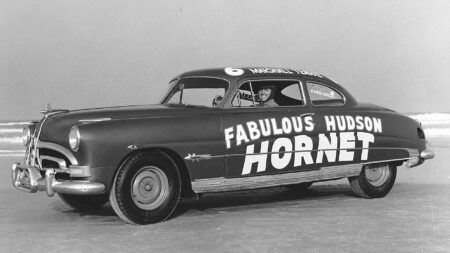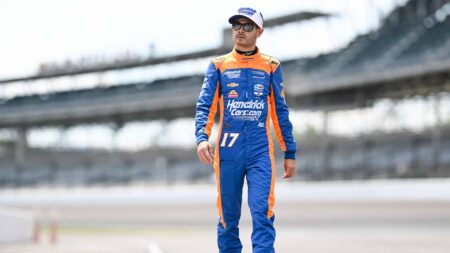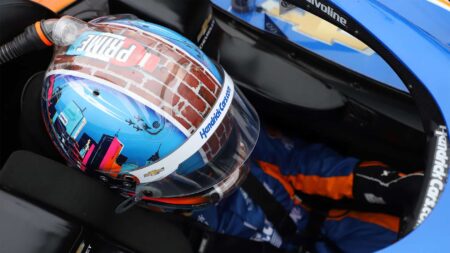
The real-life Hudson Hornet: story of a NASCAR icon
The massively successful Cars Disney film made Doc Hudson popular with fans young and old – James Elson tells the story behind the Hudson Hornet NASCAR it was based on
Four legends of NASCAR are leading contenders in the Motor Sport Hall of Fame voting. Richard Petty, Cale Yarborough, Dale Earnhardt and Jeff Gordon all raced successfully at the top level for 20-plus years and between them they won 21 NASCAR championships and 15 Daytona 500s.
*****
Petty won 200 NASCAR races, a record in all forms of racing, and his seven championships are equalled only by Earnhardt in NASCAR, A.J. Foyt in Indy cars and Michael Schumacher in Formula 1. Petty was the first NASCAR driver to make a mark in America’s mainstream mass-market culture. In the late 1960s and throughout the ’70s, King Richard defined NASCAR and helped establish modern stock car racing in the wake of the formative, Junior Johnson-style whiskey-running days. Without Richard Petty, the rise of his 1980s and ’90s heir Dale Earnhardt would not have been possible. Long before Earnhardt, the King built NASCAR’s foundations.
He’s been retired for 23 years but Petty remains forever ‘The King of NASCAR’, renowned for his impeccably gracious manner and charitable works. Petty’s 200 wins rank him in a class of his own with almost twice as many as second-placed David Pearson’s 105. The King is the only man to win NASCAR’s crown jewel Daytona 500 seven times.
Petty scored his first Daytona 500 victory in 1964 with Chrysler’s new ‘hemi-head’ V8. “With the Hemi in that little ‘64 Plymouth it just overpowered the Fords and the rest of them so much that the Chrysler cars raced among themselves,” Petty recalls.
There were no limits on horsepower in those days and power skyrocketed through the sixties and seventies. “As the horsepower went up,” Petty notes, “Goodyear usually came with a little bit better tyre to make up the difference and we had another year’s experience making the car handle. Daytona was a wide-open racetrack most of the time. The winners could run wide-open, but the guys who ran fourth or fifth couldn’t. Maybe they could run wide-open for a few laps but then the tyres would go away.
“So it really wound-up being not only a horsepower track but a handling racetrack also. Our cars usually handled pretty good at Daytona and I think that made up a lot of difference in close racing and close traffic. If you could run wide-open and they couldn’t, you could make it work to your advantage.”
He won the 500 for a second time in 1966, making up two laps. “We had a tyre problem and got behind. But the car was just so much better than anybody else’s that we were able to run ‘em down. That was before they had the ‘Lucky Dog’ to make up laps under caution. In those days you had run hard to make up your lost laps. Some of the other good-running cars ran into trouble that day and that helped me get back up there. That was one of those deals where we had the quickest car but we had to have a little bit of luck to make it all work for us.”
Petty Enterprises’ cars were very strong through the 1970s and he won the 500 again in ‘71, ’73, ’74, ’79 and recorded his seventh and final 500 victory in 1981. The King raced on for a dozen more years, retiring in 1992 at the age of 55 after starting no fewer than 1,185 races in NASCAR’s premier series. He continues to oversee Richard Petty Motorsports, running two cars in the Sprint Cup series and attending all the races with the family team whose roots go back to 1949.
From the Archive: “King Richard’s reign” by Nigel Roebuck (February 2008)
*****
Cale Yarborough was a contemporary of Petty and a relentless bull of a driver. I always remember how unbelievably aggressive he was in making up two laps to win the 1977 Daytona 500 in a Junior Johnson Chevrolet. Yarborough was a football player in high school before making his first NASCAR start in the 1957 Southern 500 when he was only 18. Cale enjoyed some good years with the Wood Brothers’ Fords from 1966-’70, winning 13 races during that time, including the 1968 Daytona 500.
But Yarborough really hit his stride with Johnson’s team in the late 1970s, winning three championships in a row and 28 races between ’76 and ’78. His ’77 Daytona 500 was his second and he won the race two more times in ‘83 and ’84 driving Harry Ranier’s cars. Yarborough retired at the end of 1988, aged 49, with 83 wins from 562 starts. Today he lives in Sardis, South Carolina where he was born and raised, quietly running an automobile dealership in nearby Florence.
From the Archive: Petty vs Yarborough at Daytona (April 2006)
*****
Dale Earnhardt’s bad luck in the Daytona 500 was legendary. Twice in the years before his death he lost the race on the last lap, once because of a tyre failure, the other because of a crash. He was able to win the 500 only once in 1998.

Earnhardt hated restrictor-plate racing which was introduced at Daytona and Talladega in 1988. Amid a sea of disdain among the drivers for the dreaded method of restricting power he was the most vocal opponent. For years the drivers said that one day there would be an almighty, multi-car accident because of the crowding caused by running with severely restricted power and terrible throttle response. In the end, he was the first man to die in such an accident.
He won 76 Winston Cup races from 676 starts over 26 seasons and is ranked seventh on NASCAR’s all-time winners list behind Richard Petty, David Pearson, Jeff Gordon, Bobby Allison, Darrell Waltrip and Cale Yarborough. He remains the only one of NASCAR’s greatest stars to have lost his life behind the wheel.
Vote for Cale Yarborough here.
More importantly, Earnhardt has gone down in American history as the quintessential Southern stock car driver. Plain spoken with a strong Carolina twang he gave no apologies or quarter to anyone. A high school drop out who survived a hardscrabble youth to become a working-class hero, Earnhardt’s persona was perfectly matched to NASCAR’s legendary history of outlaws and whisky-runners.
Earnhardt played the game to the maximum on and off the track. He was synonymous with the black and silver colours of sponsor GM Goodwrench, becoming just as much ‘The Man in Black’, as ‘The Intimidator’. The sobriquets were interchangeable. He was the menacing, dark force, the guy who was going to push to the maximum at every turn, in every situation. It was an image Earnhardt cultivated superbly with his smirking grin and trim moustache. And of course he could back it up on the racetrack.
He was the man so many NASCAR fans loved because he was fast, tough, supremely confident and a brilliant racer. When he first started winning races and championships he was known as ‘Ironhead’. Fifteen years after his death, pick-up trucks in every corner of the United States proudly still carry their man’s #3 emblem as a badge of honour.
The black Chevrolet dominated through the early ’90s, winning 29 races between 1990-’95 and took the championship in 1990, ’91, ’93 and ’94. The last title was Earnhardt’s seventh, equalling Petty and placing him at the pinnacle of stock car racing’s pantheon.
Until the day he died, Earnhardt was the acknowledged master of drafting on superspeedways. He seemed to understand how to use the air better than any other driver and his results at Daytona and Talladega proved it. At Talladega, Earnhardt won 10 500-mile races, and despite winning the Daytona 500 just once he won 33 other races at Daytona over his 25 years, including a string of 10 consecutive 125-mile qualifying race wins between 1990-’99.
He was also a grand master of ‘using the fender’ on another car. Unlike most forms of motor racing, stock car racing is a contact sport. Using your car’s fenders to best effect is one of the arts of the game, and nobody could do it better than ‘The Intimidator’. Over the years Earnhardt crashed many people, always with a deft touch. He played the odds and won many times. He raised the ire of plenty of drivers and even more fans, emerging as the man people loved to hate.
Today, the myth is that everyone admired and respected him, but the truth is Earnhardt was despised as much as he was loved. Sure, he loved to hunt and fish and joke with his fellow drivers, but he was as tough and hard-edged as they come.
Another part of Earnhardt’s legacy is NASCAR’s huge market in souvenir sales. Back in 1985 he was the first driver to bring a souvenir trailer to the track to sell branded Dale Earnhardt baseball caps, t-shirts and jackets. As his career boomed so did souvenir sales and the other drivers and teams followed suit. In 1995 Earnhardt hired Don Hawk to run his business affairs and Earnhardt-licensed souvenir and merchandise sales shot up to $40 million per year.
In 1997 Forbes magazine estimated his income at $19 million, including $15 million from endorsements and souvenir sales. At that time he was placed third highest in the world of sport behind only basketball superstar Michael Jordan and golf star Tiger Woods. By the time he died, Earnhardt had purchased his own seat on the New York Stock Exchange and Dale Earnhardt Inc. was reckoned to generate more than $100 million per year in revenue.
Today, his son Dale Jr. is by far NASCAR’s most popular driver despite never winning a championship or coming close to equalling his father’s record of accomplishments. But Jr. is loved by NASCAR fans because he’s an unadorned Southern boy who talks and lives in the spirit of his father. Like his father, Dale Jr. sells more souvenirs, controlling more than a quarter of NASCAR’s merchandising sales.
Fifteen years after his passing, the long shadow Dale Earnhardt cast across NASCAR looks likely to continue. Richard Petty won as many championships and many more races than Earnhardt, but Earnhardt will rule forever as the heart and soul of American stock car racing.
From the Archive: “Long shadow of the man in black” (February 2011)
*****
Over the last half-dozen years of his career a new challenger confronted Earnhardt, with an entirely different personality and background in racing. Jeff Gordon arrived in NASCAR’s premier series at the end of 1992, a fresh-faced California kid who had made his name in midget and sprint car racing. Over four years from 1995–’98 Gordon won three NASCAR championships and established a new order as he defeated traditional stars like Earnhardt, Mark Martin, Rusty Wallace and Dale Jarrett, reshaping the scene from a place where older, more experienced drivers from the South ruled the roost.
Gordon’s rapid emergence as the new face of American stock car racing created a revolution providing younger drivers from other forms of racing across the United States with the opportunity to break into NASCAR. Jeff started racing quarter midgets when he was five. In his first year he won 35 races. Two years later he won no fewer than 51.
A few years later Gordon’s family decided to move from the west coast to Indiana, the heartland of American midget and sprint car racing, and in 1989 at the age of 18 Jeff won USAC’s midget rookie of the year award before taking USAC’s midget and Silver Crown championships in 1990 and ’91.
In 1993 Gordon moved into NASCAR’s premier league with Rick Hendrick’s multi-car Chevrolet team, winning the rookie of the year award. The following year he won two races and finished eighth in points before winning his first championship in ’95 with seven wins and eight poles. Over the next three years Gordon really made his mark winning no fewer than 33 races and adding two more championships to his rapidly growing record.
Adding a fourth NASCAR championship in 2001, he retired last year with a record of 93 wins over 23 seasons ranking third on NASCAR’s all-time winners list behind Petty and David Pearson. Gordon won the Daytona 500 three times in 1997, ’98 and ’05, and recorded a remarkable unbroken record of 797 consecutive starts from November 1992 through November 2015.
Gordon also won more prize money than any other driver in NASCAR history. In 2009, after 17 years on the circuit, he became the first NASCAR driver to reach $100 million in career winnings and by the end of last year he had won more than $150 million. Jimmie Johnson is a close second in career prize money and should surpass Gordon this year.
These days Gordon co-owns six-time champion Jimmie Johnson’s #48 team and holds an equity stake in Hendrick’s #24 team, the car he drove through his NASCAR career. And last week, Jeff began a new career as a colour commentator for Fox Sports on NASCAR’s TV broadcasts ensuring he’ll be a part of the sport for many years to come.
From the Archive: “‘Friends, team-mates, rivals…” (January 2012)

The massively successful Cars Disney film made Doc Hudson popular with fans young and old – James Elson tells the story behind the Hudson Hornet NASCAR it was based on

NASCAR star Kyle Larson is attempting 'The Double' this Sunday, driving the Indianapolis 500 and Coca-Cola 600 on the same day – but several factors could stand in his way

'The Double' is a challenge like no other in motor sport – we look at the brave racers who've taken on the Indianapolis 500 and Coca-Cola 600 on the same day

NASCAR has aimed big with its new Drive to Survive Netflix imitator Full Speed: can the docudrama match its lofty ambitions?